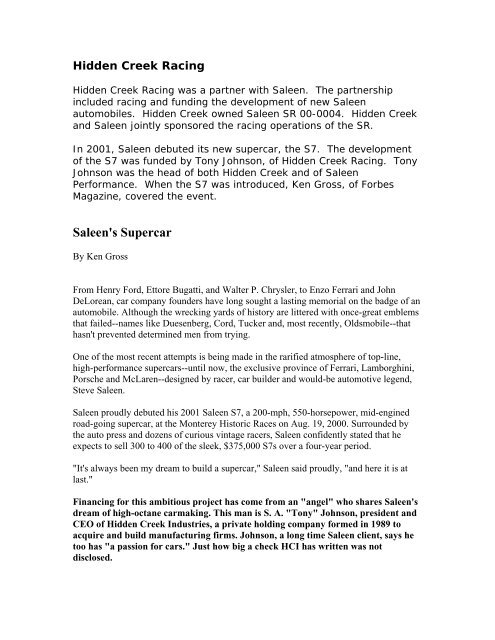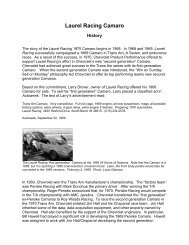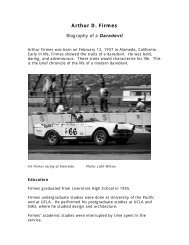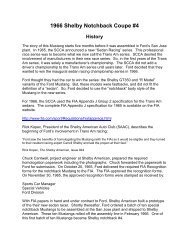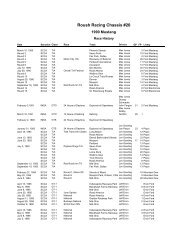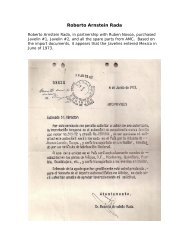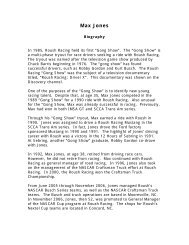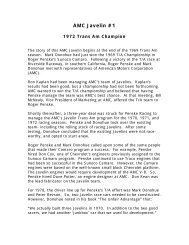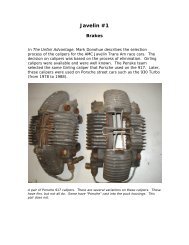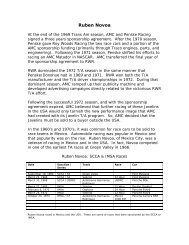Saleen's Supercar
Saleen's Supercar
Saleen's Supercar
You also want an ePaper? Increase the reach of your titles
YUMPU automatically turns print PDFs into web optimized ePapers that Google loves.
Hidden Creek Racing<br />
Hidden Creek Racing was a partner with Saleen. The partnership<br />
included racing and funding the development of new Saleen<br />
automobiles. Hidden Creek owned Saleen SR 00-0004. Hidden Creek<br />
and Saleen jointly sponsored the racing operations of the SR.<br />
In 2001, Saleen debuted its new supercar, the S7. The development<br />
of the S7 was funded by Tony Johnson, of Hidden Creek Racing. Tony<br />
Johnson was the head of both Hidden Creek and of Saleen<br />
Performance. When the S7 was introduced, Ken Gross, of Forbes<br />
Magazine, covered the event.<br />
<strong>Saleen's</strong> <strong>Supercar</strong><br />
By Ken Gross<br />
From Henry Ford, Ettore Bugatti, and Walter P. Chrysler, to Enzo Ferrari and John<br />
DeLorean, car company founders have long sought a lasting memorial on the badge of an<br />
automobile. Although the wrecking yards of history are littered with once-great emblems<br />
that failed--names like Duesenberg, Cord, Tucker and, most recently, Oldsmobile--that<br />
hasn't prevented determined men from trying.<br />
One of the most recent attempts is being made in the rarified atmosphere of top-line,<br />
high-performance supercars--until now, the exclusive province of Ferrari, Lamborghini,<br />
Porsche and McLaren--designed by racer, car builder and would-be automotive legend,<br />
Steve Saleen.<br />
Saleen proudly debuted his 2001 Saleen S7, a 200-mph, 550-horsepower, mid-engined<br />
road-going supercar, at the Monterey Historic Races on Aug. 19, 2000. Surrounded by<br />
the auto press and dozens of curious vintage racers, Saleen confidently stated that he<br />
expects to sell 300 to 400 of the sleek, $375,000 S7s over a four-year period.<br />
"It's always been my dream to build a supercar," Saleen said proudly, "and here it is at<br />
last."<br />
Financing for this ambitious project has come from an "angel" who shares <strong>Saleen's</strong><br />
dream of high-octane carmaking. This man is S. A. "Tony" Johnson, president and<br />
CEO of Hidden Creek Industries, a private holding company formed in 1989 to<br />
acquire and build manufacturing firms. Johnson, a long time Saleen client, says he<br />
too has "a passion for cars." Just how big a check HCI has written was not<br />
disclosed.
No one underestimates the difficulty involved in competing with established marques at<br />
the top of the automotive tree. However, Steve Saleen does have some relevant<br />
experience. His company has produced 7,000 vehicles over 17 years and currently builds<br />
several semi-custom, high-performance models like the S281 and SR, both based on the<br />
contemporary Ford Mustang. Thanks to a strategic alliance with Ford Motor, these cars<br />
and some modified SUV models have been distributed through carefully selected and<br />
authorized Ford dealers. None of <strong>Saleen's</strong> previous efforts, however, have been priced at<br />
the S7's lofty level.<br />
Saleen does have a great deal of competition experience, however. Team Saleen Racing<br />
boasts an alliance with television star Tim Allen and together they have competed<br />
successfully at racing venues from Lime Rock to Le Mans. They run the Le Mans Series<br />
and they captured the 2000 GTO Driver's Championship in the inaugural Grand<br />
American Road Racing Series.<br />
Despite specifications that would do credit to any exotic automobile--like a lightweight<br />
steel space frame and honeycomb composite carbon-fiber body panels, advanced windtunnel-tested<br />
aerodynamics, all-aluminum double-wishbone suspension, and enormous<br />
Brembo alloy brakes and forged alloy wheels--the S7's motor is quite conventional.<br />
Namely, propulsion comes from a 427-cubic-inch Ford-based pushrod V-8 mated to a<br />
six-speed transaxle. True, the engine is an all-aluminum number, and its inlet system<br />
draws air from a clever rooftop-mounted vent. It also has special stainless-steel valves<br />
with titanium retainers, and a high-vacuum dry sump and stainless-steel exhaust system.<br />
All that techno babble adds up to 525 pound-feet of torque at 4000 rpm and, despite its<br />
big displacement, and a lack of overhead camshafts (these days you can find overhead<br />
cams under the hoods of $20,000 Honda Civics), the engine's redline is an impressive<br />
7000 rpm. Saleen estimates a sub-four second 0-60 sprint time.<br />
First impressions (driving will come after a machine is assembled and fully tested) are<br />
that the S7 resembles a Lamborghini Diablo. No, it's not as fluid a design as Ferrari's F50<br />
but it will pack nearly all the performance of a $1 million McLaren F1, marking it as a<br />
relative bargain in this rarified field.<br />
Nonetheless the question remains: Who will pay $375,000 for this unproven car from a<br />
small private manufacturer, and are there 400 of these buyers?<br />
Nearly every carmaker whose name is actually on his own vehicle has wanted to build<br />
the best, and often that's meant the most expensive, car of its kind. But that has nearly<br />
always meant egos winning over economics and, in the end, such cars usually spell<br />
trouble.<br />
That hasn't stopped established carmakers from repeatedly playing the game, despite its<br />
high-priced stakes. All the early Lamborghinis up to the present-day Diablo, the Porsche<br />
959, the Ferrari F40 and later, the F50, Jaguar's short-lived J220, the EB 110 Bugatti and
today's McLaren F1 are living testimony. And companies keep trying: Ferrari is<br />
reportedly developing the F60, and Ferdinand Piech--the CEO of Volkswagen who not<br />
only bought Bugatti but also Lamborghini--has shown prototype supercars from both of<br />
his new marques.<br />
But it's a tough and very small market to crack. Steve Saleen has an intriguing design, he<br />
appears to have sufficient financing and he has a track record (literally) that could all<br />
work in his favor. We'll be watching...and we're looking forward to a test drive.<br />
http://www.forbes.com/2001/02/26/0226feat.html<br />
Vehicles Feature<br />
Tim Allen, of Saleen Allen Speedlab, introduced the new Saleen S7 in<br />
2001. Autochannel covered the debut and described the S7 as a joint<br />
effort of Tony Johnson, of Hidden Creek, and Saleen.<br />
Introduction of the Saleen S7<br />
2001 Saleen S7 Introduction
The day was over cast and breezy, a large variety of classic cars were warming up<br />
their tires on the famous Laguna Seca International Raceway road course, and an<br />
impressive crowd was gathering outside the Saleen display. A black nylon sheet<br />
cleverly covered the newest addition to Saleen Inc.<br />
A joint effort between Steve Saleen, founder and president of Saleen Inc, and<br />
S.A. “Tony” Johnson, President and CEO of Hidden Creek Industries, they<br />
introduced the first Saleen badged vehicle that was not based on another<br />
vehicle's platform. Merging their company's strengths, Saleen and Johnson<br />
formed a partnership that brings a unique sport car to the market and<br />
establishes them as serious contenders in the automobile manufacturing<br />
industry.<br />
Tim Allen, of Saleen Allen Speedlab, introduces the new Saleen S7
www.autochannel.com/vehicles/new/2000info/saleen.html<br />
In addition to the partnership with Saleen, Tony Johnson, of HCI, tried<br />
to acquire a F1 Grand Prix team.<br />
JANUARY 10, 2000<br />
Whispers from the United States...<br />
FURTHER details are beginning to emerge about a second mysterious bidder for the<br />
Minardi team in early December. The bidding battle was won by Telefonica, which had<br />
first option to buy the team. The second bid came from the consortium fronted by former<br />
Tyrrell team manager Rupert Manwaring - which has been looking at Arrows ever since -<br />
but we now hear that there was a third bidder for the little Italian team.<br />
We believe that this bid had the backing of multi-millionaire Sankey Johnson of<br />
Wayzata, Minnesota. A former automotive industry executive, Johnson - who is<br />
known as Tony - established the Hidden Creek company in 1989. He remains the<br />
president and chief executive officer. Hidden Creek owns significant shareholdings<br />
in Tower Automotive, Dura Automotive and Heavy Duty Holdings. Johnson is<br />
chairman of all three companies.<br />
The best known of these is Tower Automotive which was established in 1993 and has<br />
since taken over a string of smaller companies as it bids to become the primary supplier<br />
to automobile manufacturers in the world. It supplies a broad range of assemblies to Ford,<br />
DaimlerChrysler, General Motors, Honda, Toyota, Nissan, Fiat, BMW and Volkswagen.<br />
The company owns subsidiaries in Canada, Mexico, Brazil, Italy, China, Korea and<br />
Japan. It also owns Automotive Products - a well-known British supplier.<br />
Hidden Creek is also the major shareholder in Dura Automotive Systems which<br />
specializes in braking systems and driver control systems. Heavy Duty Holdings<br />
specializes in components for trucks.<br />
In the last few years Johnson has developed an interest in auto racing and he is now<br />
the chairman of Saleen Performance, which builds high performance Ford<br />
Mustangs and has been developing machinery in the American Le Mans Series.<br />
Johnson's interest in Formula 1 appears to have come about because of Hidden Creek's<br />
ambition to become a major player in the world's automotive component business as it<br />
begins to consolidate.<br />
Our sources suggest that Johnson is a partner in the new Mo Nunn Racing, alongside Mo<br />
Nunn, Bruce McCaw and Rod Campbell. Whether or not all the partners are involved in<br />
the plans to buy into F1 is not clear but it is worth noting that the other three partners<br />
have all had interests in Grand Prix racing. Nunn struggled to make it in F1 with the
Ensign team in the late 1970s, McCaw is an F1 fan and has the biggest collection of<br />
BRM machinery in the world and Campbell has long been involved in F1 through his<br />
involvement as PR man for the Ford Motor Company.<br />
Perhaps the plan for Grand Prix racing to return to America has given them the idea to<br />
establish an American F1 team?<br />
http://www.grandprix.com/ns/ns02284.html<br />
On August 11, 2005, Thayer Capital Partners announced that it had<br />
acquired Hidden Creek Industries. The new organization is called<br />
Thayer/Hidden Creek.


